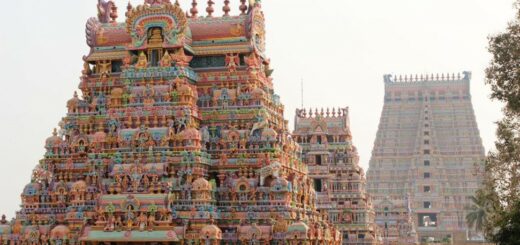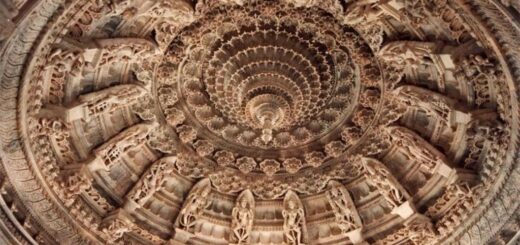Art & Culture: Classical Dances of India
by
Mentors4ias
·
May 18, 2019
Bharatnatyam Dance
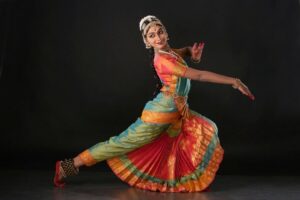
- Bharatnatyam Dance is considered to be over 2000 years old. Several texts beginning with Bharata Muni’s Natya Shastra (200 B.C.E. to 200 C.E.) provide information on this dance form.
- The Abhinaya Darpana by Nandikesvara is one of the main sources of textual material, for the study of the technique and grammar of body movement in Bharatnatyam Dance.
- There is also a great deal of visual evidence of this dance form in paintings and stone and metal sculptures of ancient times.
- On the gopurams of the Chidambaram temple, one can see a series of Bharatnatyam poses, frozen in stone as it were, by the sculptor. In many other temples, the charis and karanas of the dance are represented in sculpture and one can make a study of the dance form.
- Bharatnatyam dance is known to be ekaharya, where one dancer takes on many roles in a single performance.
- In the early 19th century, the famous Tanjore Quartette, under the patronage of Raja Serfoji are said to have been responsible for the repertoire of Bharatnatyam dance as we see it today.
- The style was kept alive by the devadasis, who were young girls ‘gifted’ by their parents to the temples and who were married to the gods. The devadasis performed music and dance as offerings to the deities, in the temple courtyards. Some of the renowned performers and gurus of the early part of the century belong to the devadasi families, a well-known name is Bala Saraswati.
- The repertoire of Bharatnatyam is extensive, however, a performance follows a regular pattern. At first there is an invocation song. The first dance item is the alarippu, literally meaning – to adorn with flowers. It is an abstract piece combining pure dance with the recitation of sound syllables.
- The next item, the jatiswaram is a short pure dance piece performed to the accompaniment of musical notes of any raga of Carnatic music. Jatiswaram has no sahitya or words, but is composed of adavus which are pure dance sequences – They form the basis of training in Bharatnatyam dance.
- As a solo dance, Bharatnatyam leans heavily on the abhinaya or mime aspect of dance – the nritya, where the dancer expresses the sahitya through movement and mime. Shabdam follows the jatiswaram in a Bharatnatyam dance performance. The accompanying song is generally in adoration of the Supreme Being.
- The varnam is by far one of the most beautiful compositions in Indian dance.
- The accompanying orchestra consists of a vocalist, a mridangam player, violinist or veena player, a flautist and a cymbal player. The person who conducts the dance recitation is the Nattuvanar.
Kathakali Dance
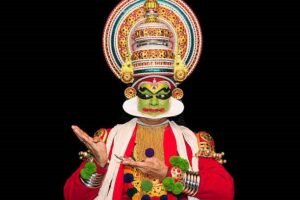
- Kerala is the home of several traditional dance and dance – drama forms, the most notable being Kathakali.
- Kathakali, as a dance form popular today, is considered to be of comparatively recent origin. However, it is an art which has evolved from many social and religious theatrical forms which existed in the southern region in ancient times.
- Chakiarkoothu, Koodiyattam, Krishnattam andRamanattam are few of the ritual performing arts of Kerala which have had a direct influence on Kathakali in its form and technique.
- In the temple sculptures in Kerala and the frescoes in the Mattancheri temple of approximately the 16th century, dance scenes depicting the square and rectangular basic positions so typical to Kathakali are seen. For body movements and choreographical patterns, Kathakali is also indebted to the early martial arts of Kerala.
- Kathakali is a blend of dance, music and acting and dramatizes stories, which are mostly adapted from the Indian epics. It is a stylised art form, the four aspects of abhinaya – angika, aharya,vachika, satvika and the nritta, nritya and natya aspects are combined perfectly.
- The dancer expresses himself through codified hastamudras and facial expressions, closely following the verses(padams) that are sung. Kathakali derives its textual sanction from Balarama Bharatam andHastalakshana Deepika.
- The attakkathasor stories are selected from the epics and myths and are written in a highly Sanskritised verse form in Malayalam. Many Malayalam writers have also contributed to the vast repertoire of Kathakali literature.
- Kathakali is a visual art where aharya, costume and make-up are suited to the characters, as per the tenets laid down in the Natya Shastra. The characters are grouped under certain clearly defined types like the pacha, kathi, thadi, kari or minukku. The face of the artist is painted over to appear as though a mask is worn. The lips, the eyelashes and the eyebrows are made to look prominent. A mixture of rice paste and lime is applied to make the chutti on the face which highlights the facial make-up.
- Kathakali dance is chiefly interpretative. The characters in a Kathakali performance are broadly divided into satvika, rajasika and tamasika types. Satvika characters are noble, heroic, generous and refined.
- In pacha, green colour dominates and kirita (headgear) is worn by all. Krishna and Rama wear special crowns decorated with peacock feathers. The noble characters like Indra, Arjun and the Devas are some of the pacha characters.
- The kathi type depict anti-heroes. Though they are of the rajasika category, they are sometimes great warriors and scholars such as Ravana, Kamsa and Sisupala to name a few.
- In no other dance style is the entire body used so completely as in Kathakali. The technical details cover every part of the body from facial muscles to fingers, eyes, hands and wrists.
- Kathakali music follows the traditional sopana sangeet of Kerala. It is said to be the ritual singing of the Ashtapadis on the flight of steps leading to the sanctum sanctorum.
- Now, Kathakali music also uses Carnatic ragas-the raga and tala conforming to the bhava, rasa and dance patterns (nritta and natya).
- The orchestra which is also used in other traditional performing arts of Kerala, normally comprises the Chenda, Maddalam, Chengila, Ilathalam, Idakka and Shankhu.
- Thanks to the service done by the poet Vallathol, this classical dance form received a new impetus and today many innovations are also being made to suit the needs of a changing society.
Kathak Dance
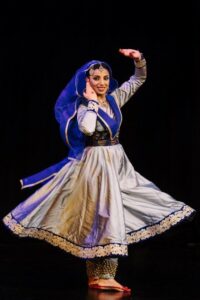
- The word Kathak has been derived from the word Katha which means a story. Kathakars or story-tellers, are people who narrate stories largely based on episodes from the epics, myths and legends.
- It probably started as an oral tradition. Mime and gestures were perhaps added later on to make the recitation more effective. Thus evolved a simple form of expressional dance, providing the origins of what later developed into Kathak as we see it today.
- The Vaishnavite cult which swept North India in the 15th century and the resultant bhakti movement contributed to a whole new range of lyrics and musical forms. The Radha-Krishna theme proved immensely popular alongwith the works of Mirabai, Surdas, Nandadas and Krishnadas.
- The emergence of Raslila , mainly in the Braj region (Mathura in Western U.P.) was an important development. It combined in itself music, dance and the narrative.
- Dance in Raslila, however, was mainly an extension of the basic mime and gestures of the Kathakars or story-tellers which blended easily with the existing traditional dance.
- With the coming of the Mughals, this dance form received a new impetus. A transition from the temple courtyard to the palace durbar took place which necessitated changes in presentation. In both Hindu and Muslim courts, Kathak became highly stylised and came to be regarded as a sophisticated form of entertainment. Under the Muslims there was a greater stress on nritya and bhavagiving the dance graceful, expressive and sensuous dimensions.
- The nineteenth century saw the golden age of Kathak under the patronage of Wajid Ali Shah, the last Nawab of Oudh. He established the Lucknow gharana with its strong accent on bhava, the expression of moods and emotions. The Jaipur gharana known for its layakari or rhythmic virtuosity and the Benaras gharana are other prominent schools of Kathak dance. The technique of movement in Kathak is unique to it.
- The weight of the body is equally distributed along the horizontal and vertical axis. The full foot contact is of prime importance where only the toe or the ball of the foot are used, their function is limited. There are no deflections and no use of sharp bends or curves of the upper or lower part of the body. Torso movements emerge from the change of the shoulder line rather than through the manipulations of the backbone or upper chest and lower waist muscles. In the basic stance, the dancer stands straight, holds one hand at a level higher than the head and the other is extended out on the level of the shoulder.









